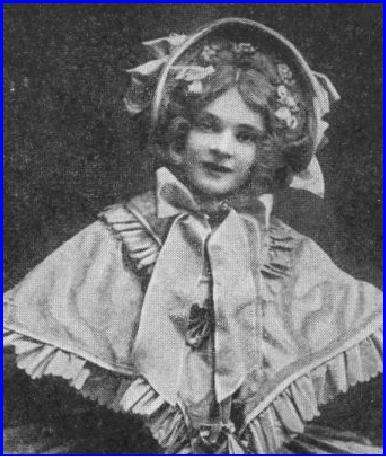 |
I. WOMAN DECORATIVE IN HER GARDEN:WOMAN DECORATIVE ON THE LAWN |
| << WOMAN DECORATIVE IN HER SUN-ROOM |
| WOMAN AS DECORATION WHEN SKATING >> |

know
always uses her last
Summer's muslins and wash
silks, shoes, slippers
and
hats
in her sun-room during the
Winter. In her wardrobe
there are invariably a lot
of
sheer
muslins, voiles and wash
silks in white, mauve,
greys, pinks, or
delicate
stripes,
the outline following the
fashion, voluminous, straight or
clinging, the
bodice
tight with trimmings inset
or full, beruffled, or kerchiefed.
Her hats are
always
entirely black or entirely
white, in type the variety
we know as picturesque,
made
very light in weight and
with no thought of withstanding
the elements. The
woman
who knows how, can get the
effect of a picture hat with
very little outlay of
money.
It is a matter of line when on
the head, that look of
lightness and general
airiness
which gives one the feeling
that the wearer has
just blown in from
the
lawn!
The artist's hand can place a
few simple loops of ribbon
on a hat, and have
success,
while a stupid arrangement of
costly feathers or flowers
may result in
failure.
The effect of movement got
by certain line manipulation,
suggesting
arrested
motion, is of inestimable value,
especially when your hat is
one with any
considerable
width of brim. The hat
with movement is like a
free-hand sketch, a
hat
without
movement like a
decalcomania.
If
the owner of the sun-room is
resting or invalided then
away with out-of-door
costume.
For her a tea-gown and satin
slippers are in order, as
they would be under
similar
conditions on her furnished
porch.
If
the mistress of the sun-room is
young and athletic, one who
never goes in for
frou-frous,
but wears linen skirts and blouses
when pouring tea for
her friends, let
her
be true to her type in the
sun-room, but always
emphasising immaculate
daintiness,
rather than the
ready-for-sport note. A sheer
blouse and French heels on
white
pumps will transpose the
plain linen skirt into
the key of
picturesque
relaxation,
the hall-mark of sun-rooms.
More than any other
room in the house,
the
sun-room
is for drifting. One cannot
imagine writing a cheque there, or
going over
one's
monthly accounts.
We
assume that the colour
scheme in the sun-room was
dictated by the owner
and
is
therefore sympathetic to her. If
this be true, we can go farther and
assume that the
delicate
tones of her porch gowns and
tea gowns will harmonise. If
her sun-room is
done
in yellows and orange and greens,
nothing will look better
than cream-white
as
a costume. If the walls,
woodwork and furniture have
been kept very light
in
tone,
relying on the rugs and
cushions and dark foliage of
plants to give
character,
then
a costume of sheer material in
any one of the decided
colours in the chintz
cushions,
will be a welcome contribution to the
decoration of the
sun-room.
Additional
effect can be given a costume by
the clever choice of colour
and line in
a
work-bag.
CHAPTER
XI
I.
WOMAN DECORATIVE IN HER GARDEN
N
your
garden, if you would count as
decoration, keep to white or
one
colour;
the flowers furnish a variegated
background against which
your
costume
of colour, grey or white
stands out. The great point
is that your
outline
be one with pictorial value,
from the artist's point of
view. If merely
strolling
through your garden to admire
it, keeping to the well-made
paths, a fragile
gown
of sheer material and dainty
shoes, with perishable hat or
fragile sunshade, is
in
order. But if yours is the
task to gather flowers, then
wear stout linen or
pretty,
bright
ginghams, good to the eye and
easily laundered, while
resisting the briars
and
branches.
Smocks,
those loose over-all garments of
soft-toned linens, reaching
from neck half
-way
to the knees and unbelted,
are ideal for garden work,
and to the young and
slender,
add a distinct charm, for
one catches the movement of
the lithe form
beneath.
You
can be decorative in your garden in a
large enveloping apron of
gingham, if
you
are wise in choosing a
colour which becomes you.
One lover of flowers,
who
has
an instinct for fitness and
colour, may be seen on a
Summer morning,
trimming
her
porch-boxes in snowy white,--shoes and
all,--over which she wears a
big,
encircling
apron, extending from neck
to skirt hem; deep pockets
cross the entire
front,
convenient for clippers,
scissors and twine. This
apron is low-necked
with
shoulder
straps and no sleeves. The woman in
question is tall and fair,
and on her
soft
curling hair she wears sun
hats of peanut straw, the
edges sewn over and
over
with
wool to match her gingham
apron, which is a solid
pink, pale green or
lavender.
Dark
women look uncommonly well
in khaki colour, and so do some
blonds. Here
is
a shade decorative against vegetation and
serviceable above all.
Garden
costumes for actual work
vary according to individual
taste and the amount
and
character of the gardening indulged
in.
Lady
de Bathe (Mrs. Langtry) owns
one of the most charming
gardens in England,
though
not as famous as some. It is attached to
Regal Lodge, her place
at
Newmarket.
The Blue Walk is something
to remember, with its walls
of blue
lavender
flanking the blue paving
stones, between the cracks of which
lovely
bluebells
and larkspur spring up in irrelevant,
poetic license.
Lady
de Bathe digs and climbs and
clips and gathers, therefore
she wears easily
laundered
garments; a white linen or
cotton skirt and blouse, a Chinese coat
to the
knees,
of pink cotton cr�pe and an
Isle-of-Jersey sun-bonnet, a poke with
curtain, to
protect
the neck and strings to
tie it on. So while she
claims never to have
consciously
considered being a decorative note in
her own garden, her
trained
instinct
for costuming herself
appropriately and becomingly brings
about the
desirable
decorative effect.
PLATE
XIV
Madame
Adeline Gen�e, the greatest
living
exponent
of the art of toe dancing.
She wears
an
early Victorian costume
(1840) made for a
ballet
she danced in London several
seasons
ago.
The writer did not
see the costume and
neglected,
until too late, to ask
Madame
Gen�e
for a description of its
colouring, but
judging
by what we know of 1840
colours

and
textures as described by Miss
McClellan
(Historic
Dress in America) and
other
historians
of the period as well as
from
portraits,
we feel safe in stating that
it may
well
have been a bonnet of pink
uncut velvet,
trimmed
with silk fringe and a band
of
braided
velvet of the same colour;
or perhaps
a
white shirred satin; or
dove-coloured satin
with
pale pink and green figured ribbon.
For
the
dress, it may have been of
dove-grey
satin,
or pink flowered silk with a
black
taffeta
cape and one of black lace to
change
off
with.
Victorian
Period about 1840
Mme.
Adeline Gen�e in Costume
II.
WOMAN DECORATIVE ON THE LAWN
When
on your lawn with the
unbroken sweep of green under
foot and the
background
of shrubs and trees, be a
flower or a bunch of flowers in
the colour of
your
costume. White,--hat, shoes and
all, cannot be excelled, but
colour has charm
of
another sort, and turning
the pages of memory, one
realises that not a shade
or
artistic
combination but has scored, if
the outline is chic. Since
both outline and
colour
scheme vary with fashion we
use the word chic or
smart to imply that
quality
in a costume which is the
result of restraint in the
handling of line,
colour
and
all details, whatever the
period.
A
chic outline is very telling
on the lawn; gown or hat
must be appropriate to the
occasion,
becoming to the wearer, its
lines following the fashion,
yet adapted to
type,
and the colour, one
sympathetic to the wearer.
The trimming must
accentuate
the
distinctive type of the gown
or hat instead of blotting out
the lines by an
overabundance
of garniture. The trimming
must follow the constructive
lines of
gown,
or have meaning. A buckle
must buckle something,
buttons must be used
where
there is at least some semblance of an
opening. Let us repeat: To be chic,
the
trimming
of a hat or gown must have a
raison
d'�tre. When in
doubt omit
trimming.
As in interior decoration, too
much detail often defeats
the original idea
of
a costume. An observing woman
knows that few of her
kind understand the
value
of restraint. When turned
out by an artist, most women
recognise when they
look
their best, but how to
achieve it alone, is beyond
them. This sort of
knowledge
comes
from carefully and constantly
comparing the gown which is
a success with
those
which are failures.
Elimination
characterises the smart costume or
hat, and the smart designer is he
or
she
who can make one flower, one feather, one
bow of ribbon, band of fur,
bit of
real
lace or hand embroidery, say a
distinct something.
It
is the decorative value gained by
the judicious placing of one
object so that line
and
colour count to the full. As
we have said in Interior
Decoration, one pink
rose
in
a slender Venetian glass
vase against a green silk curtain
may have far
more
decorative
value than dozens of costly
roses used without knowledge
of line and
background.
So it is with ornaments on wearing
apparel.
III.
WOMAN DECORATIVE ON THE BEACH
With
a background of grey sand, steel-blue
water and more or less blue
sky, woman
is
given a tempting opportunity to
figure as colour when by the
sea. That it is gay
colour
or white which makes
decorative effects on the
beach, even the least
knowing
realise. Plein
air artists
have stamped on our mental
visions impressions
of
smart society disporting
itself on the sands of
Dieppe, Trouville, Brighton,
and
where
not. Whatever the period,
hence outline, white and the
gay colours impress
one.
Most conspicuous is white on
woman (and man); then
each colour in the
rainbow
with its half-tones, figures
as sweaters, veils, hats and parasols; the
striped
marquise
and gay wares of the venders of nosegays,
balloons and lollypops.
The
artist
picks out the telling notes
when painting, learn from
him and figure as one
of
these.
On
the beach avoid being a
dull note; dead greys
and browns have no charm
there.
What
is true of costuming for the
beach applies equally to costumes to be
worn on
the
deck of a steamer or
yacht.
Table of Contents:
- A FEW HINTS FOR THE NOVICE WHO WOULD PLAN HER COSTUMES
- THE LAWS UNDERLYING ALL COSTUMING OF WOMAN
- HOW TO DRESS YOUR TYPE
- THE PSYCHOLOGY OF CLOTHES
- ESTABLISH HABITS OF CARRIAGE WHICH CREATE GOOD LINE
- COLOUR IN WOMAN'S COSTUME
- FOOTWEAR
- JEWELRY AS DECORATION
- WOMAN DECORATIVE IN HER BOUDOIR
- WOMAN DECORATIVE IN HER SUN-ROOM
- I. WOMAN DECORATIVE IN HER GARDEN:WOMAN DECORATIVE ON THE LAWN
- WOMAN AS DECORATION WHEN SKATING
- WOMAN DECORATIVE IN HER MOTOR CAR
- HOW TO GO ABOUT PLANNING A PERIOD COSTUME
- I. THE STORY OF PERIOD COSTUMES:II. EGYPT AND ASSYRIA
- DEVELOPMENT OF GOTHIC COSTUME
- THE RENAISSANCE
- EIGHTEENTH CENTURY
- WOMAN IN THE VICTORIAN PERIOD
- SEX IN COSTUMING
- LINE AND COLOUR OF COSTUMES IN HUNGARY
- STUDYING LINE AND COLOUR IN RUSSIA
- MARK TWAIN'S LOVE OF COLOUR IN ALL COSTUMING
- THE ARTIST AND HIS COSTUME
- IDIOSYNCRASIES IN COSTUME
- NATIONALITY IN COSTUME
- MODELS
- WOMAN COSTUMED FOR HER WAR JOB
- IN CONCLUSION